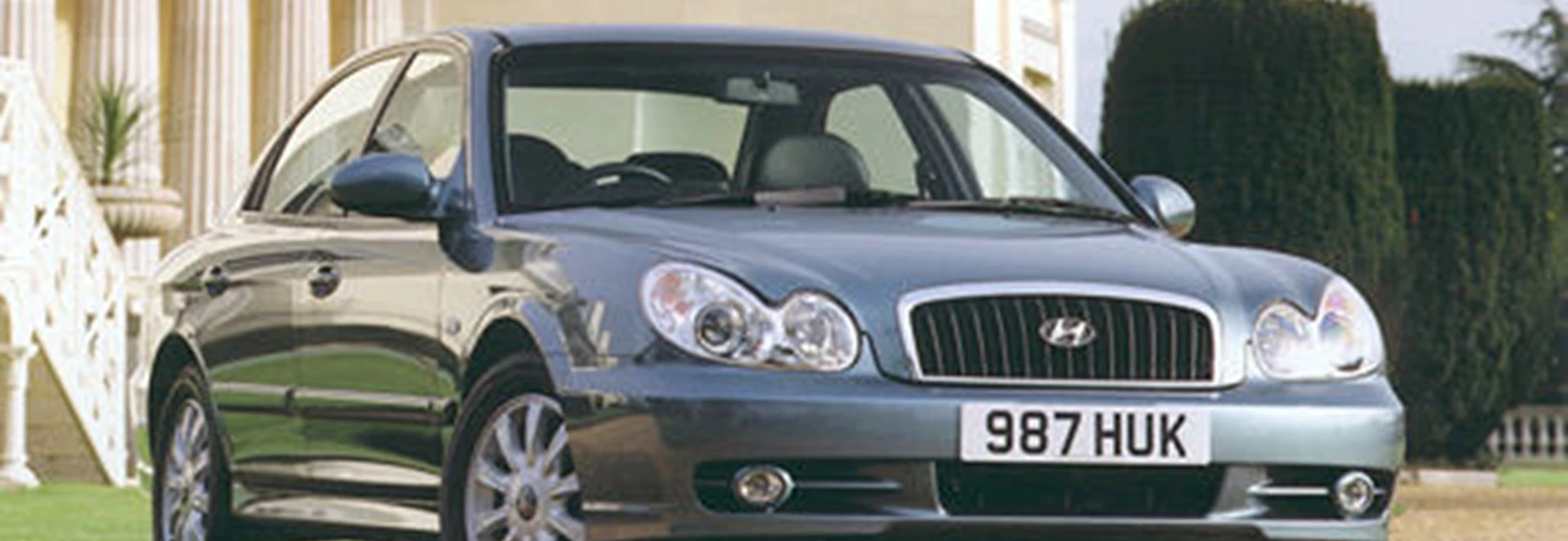One thing the previous Sonata never managed to achieve was that much-desired (by manufacturers, perhaps, even more than by owners) "presence on the road". As the Korean company starts to increase its sales and make really substantial profits, those processes won't be hindered by the fact that the latest Sonata is a much better-looking car altogether.
The twin-nacelle headlamp treatment is an obvious carry-over from the rather weirdly-styled one-generation-back Coupé, good riddance to which, as it is replaced by a highly superior design. If the lorgnette-style twin headlamps seem like something from Mercedes-Benz, who's complaining? DaimlerChrysler is a Hyundai shareholder, after all.
Some people, of course, see borrowings from Jaguar, and it's the plain truth that I once went to the wrong place in a car park, and approached what wasn't the test car at all, but a similarly-coloured S-Type.
The Sonata is a sizeable saloon, and well-packaged. There's generous rear legroom, and a couple of us loaded up the test car with enough luggage to keep us going for a nearly 3000-mile round trip, with space to spare.
Inside, the top-rated CDX is neatly presented, while the chosen colour and graining of the wood-effect trim are much better than Korean cars used to offer - in fact, much better than many of them offer right now. Velour upholstery is used in the two-litre CDX, leather facings being reserved for the V6. Alloy wheels, ABS with electronic brake force distribution, air conditioning, a sunroof, a CD player and side airbags are all standard. That impressive headlamp array uses high intensity discharge lights, and projector foglamps are fitted.
It's no secret, of course, that the Sonata is Hyundai's version of the much-admired Magentis from its subsidiary Kia, although the Kia design studio went for a Cadillac-type grille. The Magentis is built only with a 2.5-litre V6 engine, while the Sonata is available with a 2.7-litre V6 or a smaller two-litre as in the test car. All petrol, for the moment.
One snag, I thought, was that the two-litre engine was matched in this car with the extra-cost four-speed H-matic transmission as produced by Porsche to Hyundai's requirements. Myself, I wouldn't pay the £1000 extra over the standard five-speed manual.
The automatic takes about 2.3 seconds more to get to 62mph, and is 7mph down on top speed. As well as that, H-matic has only four gears. Top is quite high - in fact, a long-striding motorway ratio - and there's something like 1200rpm difference between fourth and third at 70mph.
Over in Spain, some of the long motorway climbs confused the transmission gremlins, and, rather than respond to gently increased pressure on the throttle, the car often went into a rather abrupt kickdown which sent the revs roaring. Of course, a manual change-down using the non-automatic side of the selector gate was always an option, but in that mode too H-matic has only four gears, when the usual five would be a lot more effective.
Mind you, when going harder on winding minor roads, snicking from second to third and back via the manual selector seemed to work well enough.
The CDX is comfortable on a long motorway haul, but like many cars these days seems to find little stiff spots on the old Sitzfleisch after you've been driving for two or three hours - by which time you should be stopping for a leg-stretch anyway.
Its Kumho tyres ran more quietly on Spanish roads than they seemed to in the UK, but that's hardly surprising when you consider that, where road surfaces, road engineering and the constant opening-up of new roads are concerned, the UK appears to be well behind Spain.
(Note: you can keep asking, about the UK's second-rate transport facilities, where does the money go? But don't expect a satisfactory answer.)
An interesting thing about the two-litre H-matic is that, although it's no tyre-burner, it handles unexpectedly well when pressed. Entirely in the line of duty, I took it over one lumpy-surfaced, tight-cornered and all but deserted mountain road which might have been used by Carlos Sainz, when he was a lad, for a bit of special stage practice, and hasn't been altered since.
There were various other, more modern hill roads, with the impressively smooth surfaces, excellent grading and just the odd hint of banking that Spanish local authorities often rather sportingly provide.
I can't say that in fairly lazy H-matic mode the two-litre Sonata ever felt like a really high performer, although the Sirius II engine carried over from the previous model is quite lively when working via the manual transmission. But the test car turned out to handle unexpectedly well, sweeping through combinations of left-right-left bends, some of them suddenly tightening up, and easily cresting the brows, all with the kind of "flow" which makes driving in that kind of terrain a pleasure rather than a chore. Fine ride quality, too.
It may take some people, over-worried about badges and what-will-my friends-at-the-golf-club-say, quite a while to get used to the idea of modestly-priced mid-range Korean executive cars. They're catching up, although there's no talk of a turbo diesel Sonata arriving within the next year or more.




